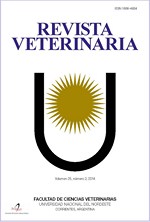Evaluation of glutamine supplementation on productive performance and biochemical variables in weaning piglets
DOI:
https://doi.org/10.30972/vet.3326190Keywords:
Piglets, Weaning, Glutamine, SupplementAbstract
One of the biggest challenges in pig production is the weaning, which implies a marked reduction in feed intake and metabolic wear. Intestinal villus atrophy and decreased digestion and absorption of nutrients are reported as a consequence of weaning. Research has shown that glutamine supplementation favors intestinal morpho-function and productive performance in piglets. The objective of this research was to evaluate the effect of glutamine supplementation in weaned piglets by measuring productive performance and biochemical blood markers. The research was carried out at the Uyumbicho Experimental Center (CEU) belonging to the Faculty of Veterinary Medicine and Zootechnics of the Central University of Ecuador. A total of 8 piglets (Landrace x Yorkshire x Pietrain x Duroc) were used. The piglets were randomly distributed in each of the 4 treatments: T1 = control 1 (without dairy supplement), T2 = control 2 (dairy supplement), T3 = dairy supplement + glutamine (0.5%), T4 = dairy supplement + glutamine (1%). Piglets receiving 0.5% glutamine had the highest daily weight gain (0.404 kg/day) and the best feed conversion (1.16) between 28 and 35 days of age (week 1). A similar trend was seen at week 5 (57-63 days of age), 0.877 g/day and 1.78, respectively. There was no difference in the biochemical variables evaluated between the 4 groups. The use of a milk replacer and glutamine supplementation would have the potential to reduce post-weaning adverse effects in piglets.Downloads
References
Bartell SM, Batal AB. 2007. The effect of supplemental glutamine on growth performance, development of the gastrointestinal tract, and humoral immune response of broilers. Poultry science 86: 1940-1947.
Boudry G, Péron V, Lehuërou I, Lallés JP, Séve B. 2004. Weaning induces both transient and longlasting modifications of absorptive, secretory, and barrier properties of piglet intestine. The Journal of Nutrition 134: 2256-2262.
Campbell JM, Crenshaw JD, Polo J. 2013. The biological stress of early weaned piglets. Journal of Animal Science and Biotechnology 4: 1-4.
Ji FJ, Wang LX, Yang HS, Hu A, Yin, YL. 2019. The roles and functions of glutamine on intestinal health and performance of weaning pigs. Animal 13: 2727-2735.
Lallés JP et al. 2004. Gut function and dysfunction in young pigs: physiology. Animal Research 53: 301-316.
Moeser AJ et al. 2007. Stress signaling pathways activated by weaning mediate intestinal dysfunction in the pig. American Journal of Physiology-Gastrointestinal and Liver Physiology 292: G173-G181.
Montagne L et al. 2007. Main intestinal markers associated with the changes in gut architecture and function in piglets after weaning. British Journal of Nutrition 97: 45-57.
National Research Council. 2012. Nutrient requirements of swine,11th ed., National Academies Press, Washington, DC, p. 15-20.
Ochoa LN, Bouda J. 2007. Patología clínica veterinaria. Facultad de Medicina Veterinaria y Zootecnia, Universidad Nacional Autónoma de México, Ciudad de México, p. 101.
Pluske JR, Hampson DJ, Williams IH. 1997. Factors influencing the structure and function of the small intestine in the weaned pig: a review. Livestock production science 51: 215-236.
Puskle JR, Turpin DL, Kim JC. 2018. Gastrointestinal tract (gut) health in the young pig. Animal Nutrition 4: 187-196.
Scott MA, Stockham SL. 2013. Fundamentals of veterinary clinical pathology. John Wiley & Sons, p. 160-165.
Spreeuwenberg MA, Verdonk JM, Gaskins HR, Verstegen MW. 2001. Small intestine epithelial barrier function is compromised in pigs with low feed intake at weaning. The Journal of nutrition 131: 1520-1527.
Wiese F, Simon O, Weyrauch KD. 2003. Morphology of the small intestine of weaned piglets and a novel method for morphometric evaluation. Anatomia, Histologia, Embryologia 32(2): 102-109.
Wijtten PJ, Meulen J, Verstegen MW. 2011. Intestinal barrier function and absorption in pigs after weaning: a review. British Journal Nutrition 7: 967-981.
Worobec EK, Duncan IJ, Widowski TM. 1999. The effects of weaning at 7, 14 and 28 days on piglet behaviour. Applied Animal Behaviour Science 62: 173-182.
Yin J et al. 2014. Development of an antioxidant system after early weaning in piglets. Journal of Animal Science 92: 612-619.
Downloads
Published
How to Cite
Issue
Section
License
Revista Veterinaria (Rev. Vet.) maintains a commitment to the policies of Open Access to scientific information, as it considers that both scientific publications as well as research investigations funded by public resources should circulate freely without restrictions. Revista Veterinaria (Rev. Vet.) ratifies the Open Access model in which scientific publications are made freely available at no cost online.











.jpg)
.jpg)



